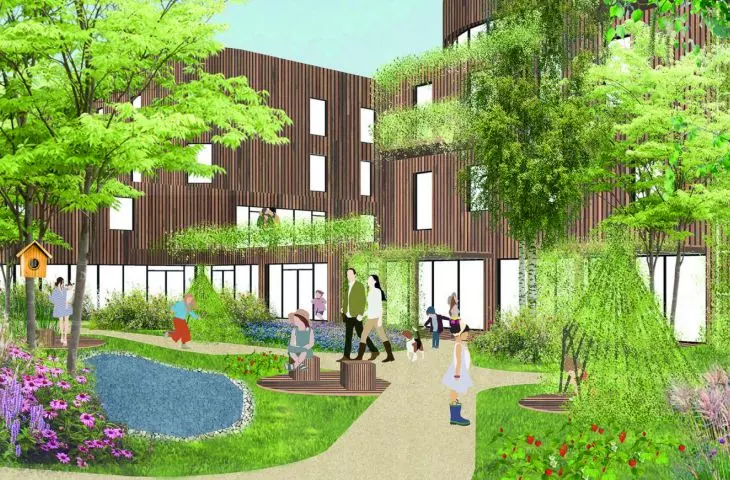interview fromA&B issue 4/2022
How the space around us looks affects our mood, our mood, our health. The way we use space in a city, the architecture of a house and its design affect us on different levels. With the help of architecture, urban planning and visual communication in space, how can we improve our mental and emotional condition? And also, do those who design these spaces for us take care of themselves?
Katarzyna Jagodzinska: Today we are talking not about the effects of architects' work, but about the mental condition of the profession. This aspect of architects' work is not widely known, although the mental condition of architects and architecture students is subjected to - so far few - studies. What does it look like among Polish architects? Are topics such as depression, professional burnout, chronic fatigue discussed?
Agata Twardoch: I think the same as in the general population. I would not draw conclusions indicating that architecture is a field that is particularly predisposed to depression or professional burnout. On the other hand, a lot has changed in the world and now such problems are not necessarily swept under the rug.
Catherine: Does this issue surface in the education process at universities?
Agata: Definitely yes, the topic of depression and mental illnesses appears primarily in the topics of thesis. Definitely more often than just a few years ago, issues of underprivileged groups are being addressed: the elderly, people with disabilities, people in crisis of homelessness and precisely people with neurodegenerative diseases and depression or autism. These issues are clearly beginning to interest students. As far as I know, there has been interest in the subject of people with disabilities several times before - in the late 1970s, then in the 1990s. Well, and now in the third wave the problems of other groups of excluded people have also arrived.
Catherine: This flows out of the interest of students or instructors?
Agata: In the diplomas it comes out of the students, because they are the ones who ultimately come up with their thesis topics. However, the interest in such topics does not come from nothing - such is the spirit of the times that we try to notice and balance inequalities, and this, I hope, is also evident in the classes.
The design of a residential and commercial building as an example of the therapeutic role of architecture; MAGISTER'S DIPLOMA WORK.
Author: Klaudia Sosna, supervisor: Agata Twardoch, prof. PŚ
© Klaudia Sosna
Catherine: Concepts such as wellbeing, mindfuless, hygge, slogans like "take care of yourself to take care of others" are constantly present in the public space. After all, architecture is not only a function of shelter or order, but also of taking care of the comfort and well-being of users. But do architects take care of themselves? Do the pressures of the profession provide that comfort at all?
Agata: Basically no, but I think I'm starting to see a change. Until now, architects and architects mainly boasted that they were able to work twenty-four hours a day and do competitions after nights. It was part of the canon of the profession and a good tone to work on weekends and sleep at night. There were jokes circulating that an architect is a free profession because he is allowed to work twenty-four hours a day. I'm not saying that this attitude doesn't exist anymore, however, an awareness of the value of free time is starting to become apparent in the younger generation. But again - this is a general trend - young people value their time more and are convinced that they don't want to work seven days a week. They also know that they have the right to rest, get sick or just have a worse day. My impression is that there has been some kind of generational change. Our generation was convinced that work was a supreme value, and that by working hard we would achieve success - which, of course, is not always true and can lead to frustration. The younger generation is aware that there is more to life than work.
Catherine: Generational change, young people get into the reel of a large architecture firm: are they able to maintain and "sell" this philosophy to the employer?
Agata: I don't know if there are many cases where a whole company changes under the influence of young employees. I certainly know of one Silesian office where, at the request of the employees, the working hours were reorganized so as to finish earlier on Fridays. On the other hand, I've heard of several cases in which people quit their office jobs precisely because of the pressure and irregular working hours. However, these are isolated stories, I don't know the statistics. Certainly, there are still young people who enter this mode and continue it.
Catherine: Architecture and the quality of spaces have a direct bearing on the mental condition of their users. So how do we design so that we feel better?
Agata: It's difficult to summarize the whole theory in a few sentences, but first it's worth dividing it into urban and architectural scales. At the urban scale, the problem is heavy urbanization and the associated chaos, noise, excess stimuli and a constant sense of danger. Studies show that living in such an environment can cause various mental problems - fatigue and burnout occur more quickly. People who already suffer from mental or neurodegenerative diseases are also very unwell in such an environment. For this reason, on an urban scale, the challenge is to reduce the harmful effects of urban chaos - for example, a city of fifteen minutes, which will allow people to move around in a familiar andtame environment, a large amount of greenery scattered around the city, which is calming, therapeutic and allows for temporary rest, as well as limiting stimuli, maintaining the continuity of space and clearly marking it. For the elderly, children, the visually impaired or people with spatial orientation problems, proper signage and logical traffic routes are essential to navigate the city independently. It should be unacceptable, for example, for a sidewalk to be interrupted and forced to cross the street, or for frequented tracts to be closed off by fences around buildings. There is also the issue of toning down the sound and visual sphere, that is, the urban cacophony of sounds and colors. There is already a lot of talk about the visual sphere, with landscape resolutions appearing in many cities, local plans regulating facade colors. Underestimated, so far, is the harmfulness of sounds, and these can also be reduced by using appropriate materials and landscaping elements.
Design of a residential and commercial building as an example of the therapeutic role of architecture; MASTER'S DIPLOMA, author: Klaudia Sosna supervisor: Agata Twardoch, prof. PŚ
© Klaudia Sosna
At the scale of the building, limiting stimuli is also key - it's a matter of good soundproofing and good acoustics, as well as subdued color schemes. In some cases, for example, when designing facilities with the needs of autistic people or those with Down's syndrome in mind, it's worth carving out areas from large open spaces where people can hide from excess stimuli. When designing facilities with the elderly in mind, it's a good idea to use neutral interior colors and contrasting accents to highlight important information - such as where you are, and elements - such as stairs. This scale also emphasizes the importance of greenery and natural materials - people with problems feel better in their surroundings. It is very important to combine this with solutions that support the needs of people with physical disabilities, but this has been talked about for a long time.
Catherine: In your opinion, are local governments, specifically departments in charge of urban planning and the visual sphere, aware of how different solutions affect our mental and emotional comfort?
Agata: There are certainly selected people who are aware of such issues, but it seems to me that this is not yet common knowledge. There is a lot of talk about the needs of people with physical disabilities, the needs of seniors, but I have the impression that all these issues are treated too selectively and in too slogans. We need cities that are friendly to everyone, and in the meantime, more programs are being added that make little difference overall. There is a lot of talk now about seniors - and that's good - but the effect is that a housing development for seniors is being built here, a bench with a backrest there, and the life of seniors in Poland has been as difficult as it is still. I like very much the approach of Vienna, where adapting cities to the needs of all people is collectively called fair shared city.
In Chelm, a reception desk and special pavilions for refugees from Ukraine have been arranged in the hall left by the former Tesco supermarket
Photo: Jerzy Łątka
Katarzyna: You mentioned high urbanization as a negative factor for our comfort. With the current wave of migration, cities will be even more saturated with residents. Can architectural and spatial solutions be used to increase psychological comfort?
Agata: I think urban planning and spatial development have great scope here. For example, people are much calmer and feel better when they know where they are and what is happening around them. Fear often flows from ignorance. If we could arrange and mark the space in such a way that refugees, when they arrive in a given city, immediately know where they are, where they are supposed to go, what their options are also in spatial terms, it would be much easier for them. That is, it's a matter of locating aid centers, which should be right next to train stations, but also clear visual information duplicated in the Ukrainian alphabet.
I know that in Silesia there is a problem with such consistent information. It has now been addressed by the Antyrama Foundation in cooperation with several students from our Department. Together they are trying to develop simplified maps that will explain the spatial organization of a given city. Analog materials are also needed, because we have to take into account that in this wave of migration not all people are familiar with technology and will not look up the necessary information on Google.
Accommodation is also an important issue. First of all, it would be worth it if as many people as possible could end up in apartments, however, and not in common rooms. That's why, for example, as the Council of the Rental Market Foundation, we sent an open letter to the prime minister with an appeal to introduce legislation to allow vacant apartments, of which there are still many in Poland, to be put into operation. However, where a sufficient number of apartments cannot be set up, it is important to ensure at least a minimum of intimacy. Here we have a great example of cooperation between Hubert Trammer and Jerzy Lątka, who, based on Shigeru Ban's conceptual design, implemented a simple idea of dividing the space. In an abandoned hypermarket in Chelm, they used paper tubes and sheets of cloth to provide a little private space for each person. I know that there are attempts to implement this idea in other places. It is an ecological solution, easy and quick to install and dismantle, and cheap.
Unusual spaces, because they are made of paper according to the design of Pritzker Prize winner Shigeru Ban, provide a bit of privacy, which is difficult to find in this type of buildings
Photo: Jerzy Lątka
Catherine: It's a moment of arrival and visual discovery. But cities and towns will probably become denser for longer. What aspects on the ground of architecture and planning in terms of psychological comfort can you point to for more long-term solutions?
Agata: This I have to come back to vacant lots. We now have a chance for the discussion about the use of apartments and unused spaces to enter a new level. I'm hearing from various cities that there are ideas on how to make these vacant spaces available. Unfortunately, without systemic solutions, the scope for change will be small.
And what is important in terms of long-term comfort? First and foremost, housing that is safe and suited to our needs. There are many studies that show the relationship between housing and mental health. It's about physical security, but also this social security - we need to be sure that no one will throw us out of it in a while. It's important, for example, that the apartment meets a minimum size. Studies say that for children, living in a micro-space with the whole family is significantly harmful, because it impairs their social functions - they won't invite anyone in, they will be ashamed, they won't have space to work. That is, living space of an appropriate standard is very important, for us, and now also for the refugees we invite to us. Therefore, as much as I admire the spurt in which we have invited guests to the couches in our living rooms, I know that this is only a temporary solution. Co-habitation will cause conflicts after a long time.
Paper Partition System at the main train station in Wroclaw
Photo: Maciej Bujko
Katarzyna: Let's now return to architects and their mental condition in the context of yet another topic. Every creation, all creators who are part of the cultural and creative industries have to deal with evaluation and criticism. How does the issue of hegemony - especially that from behind the screen, anonymous, safe from criticism - affect architects? Does this aspect as a possible part of the profession come up during the training stage?
Agata: When it comes to criticism, yes. We try to teach students to be able to defend their ideas from the very beginning. To bring their project to fruition, an architect or an architect must first "sell" their idea. That's why we try to end major projects with a public defense, where male and female students must first clearly present their idea and secondly face criticism. We want graduate students to be able to defend their ideas and convince the unconvinced.
When it comes to hate speech, I don't think anyone has a good answer to it. It's part of our reality, and all we can do is learn to ignore it. But no, we don't teach that in college.
Village without memory - a concept of interdisciplinary spatial solutions for people affected by neurodegenerative diseases; MAGISTER'S DIPLOMA DISSertation, author: Magdalena Wojtowicz, supervisor: Dr. Jan Kubec
© Magdalena Wojtowicz
Katarzyna: How do hectoring comments in social media against architects affect the condition of architectural criticism?
Agata: I wouldn't like to talk about heter comments at all, because it's not something you can have a good reaction to. I also wouldn't want to equate hejt with criticism, because these are things from completely different worlds. Instead, I see the value of criticism and discussion of architecture in general, which has gone beyond the hermetic bubble of architects. There are such topics, for example, concretosis, and once pastelosis, that resonate with the public and ultimately bring about change. After the case of the square in Kutno, more local governments will think twice before deciding on a similar project.
Catherine: Thank you for the interview.












































